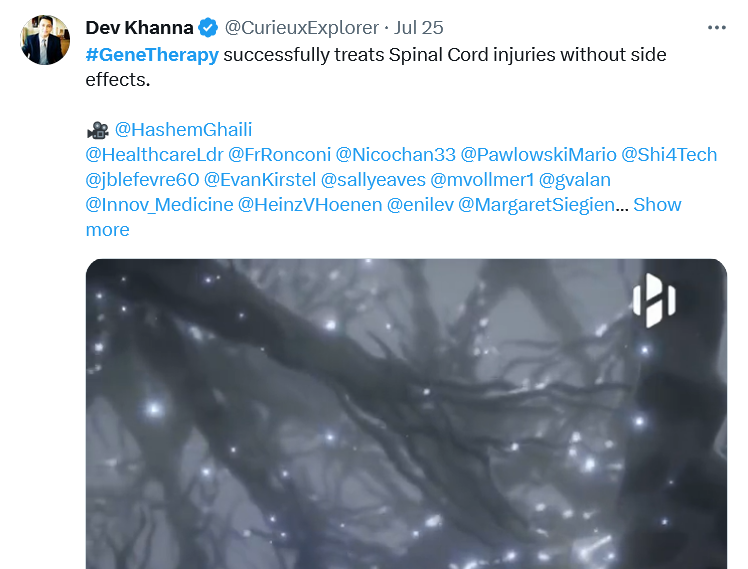The need for a biotech industrial revolution

• Technological development could create a “biotech industrial revolution.”
• That would lead to faster processing of therapies and vaccines.
• The Covid pandemic taught lessons on the value of collaborative tech and collaborative science.
Biotech and bioscience are industries to which humanity looks with hope. They help us cure diseases and conditions that otherwise impact people’s lives negatively long-term, or even, with appalling regularity, kill them.
But biotech and bioscience are being stymied by a lack of technological development, of the kind most tech businesses don’t think about twice. Things like a solid collaborative cloud infrastructure, or the ability to use AI and machine learning in a structured way, are absurdly missing from most biotech development firms.
And, according to Bob Burke, EMEA GM at biotech cloud platform Benchling and Jason C. Foster, CEO of cell and gene therapy manufacturing technology company Ori Biotech, that’s resulting in low throughput manual processes that are very expensive.
What does that mean in non-scientist?
It means horrendously expensive cures and treatments that are scientifically brilliant but economically non-viable. It means people suffering and dying because the treatments that exist can’t be successfully, economically marketed or sold to them.
That’s the market gone mad.
But it’s also indicative of a chronic structural failure, where biotech companies never have the time, the money or the explicit motivation to go “back” and provide the technological development needed to not only fast-track development of cures and treatments, but by virtue of changing a low throughput industry to a high throughput one, change the likelihood that therapies will be available to all – or more – or the people, more of the time.
The importance of technological developments for the biotech revolution.
In Parts 1 and 2 of this article, Bob and Jason explained the need for technology-focused CIOs in the biotech sector to not only implement technological developments that would underpin faster, more economically viable treatments, but also to champion the value of that renaissance approach – looking backward to the tech stack that could make those technological developments a reality, and upgrading it to something that would be recognizably 21st century.
We asked them about that shift in focus.
THQ:
Is it fair to liken biotech without the tech layer in place to a catwalk fashion house, rather than an off-the-peg clothing manufacturer, which it could be if it had that tech layer in place?
JCF:
I mean, we’re dealing with biology, but I don’t think fundamentally there’s any difference. As you say, it’s like needlepointing by hand, in a manual, expensive way, as opposed to doing it on an automated assembly line, which we know improves quality and consistency, and we also know it reduces costs and makes products more widely available.
It’s exactly the same challenge, yes. The data layer, the cloud layer that underpins the necessary changes makes the automation technology smarter and more efficient.
We can learn faster about what works, what doesn’t work, all those lessons that have been applied to cars and clothes and computers and all the other things that we make at a big scale. We need to take those learnings and apply them to biotech and to this next generation of therapies.
THQ:
A biotech version of an industrial revolution?
JCF:
People are calling it that, yeah.

The steam engine, the industrial robot…the gene therapy? Industrial revolutions have many faces.
THQ:
So how do we get there?
We know a tech layer can be helpful and potentially revolutionary, but that too often in biotech, it isn’t there. How do we go from here to there, to a place where that tech layer is universal in biotech?
JCF:
This isn’t just a government problem, this isn’t just a clinician problem. This isn’t just a pharma company problem, either. This is an everyone problem. One of the reasons we partnered with Benchling is that they do what they do really well, we’re trying to do what we do really well, and the ability to actually put those pieces together felt like the way forward.
Previously, the technology industry has been very siloed, where we have a solution, and Bob’s got a solution and someone else has got a solution, and we throw them over the wall. But a biotech company has to knit them together so they work, but they’re never really designed to work together.
By creating standards, by using standard cloud language, we can knit them together ahead of time, and the result is we’ll get a better solution for biotech, to help it with that turbo boost effect we mentioned in Part 2.

Good for almost whatever ails you – gene therapies are the future of medicine.
BB:
It’s incumbent upon us as service providers or technology providers to make sure that our products work, that they play nicely with those that are also trying to solve similar problems in the ecosystem.
It’s been very hard for biotech to adopt technology, because up until now, the tools haven’t been very good. It’s not the scientists’ fault or the biotech companies’ fault. We haven’t done our job as technology providers to say, well, actually, let us make this easy for you, we’ll make pre-integrated systems that all talk to one other, so you can pick it off the shelf, and it solves your problem.
That’s part of what we’re trying to do together – trying to create something that solves the problem in an integrated way, in a holistic way, because we fundamentally understand the needs of the customer.
THQ:
That’s a similar journey to one that tech companies have already had to make. They’re out there doing their thing, but then “What happens if we do this and connect with other companies?” So it becomes more than the sum of its parts at that point?
Collaborative technological developments helped deliver Covid vaccines.
JCF:
Yeah. I think the other important thing we learned from the pandemic was that timelines get shorter in radical ways through collaborative technology. Usually, vaccine development takes 10 years, right? But when we come together, and we collaborate, and we use best in class tools and solutions, we can deliver something in a tenth of the time – the Covid vaccines were developed in less than 12 months.

Covid vaccines. Developed quickly through significant collaboration. now about that climate change thing…
Now, of course, that’s an extreme example, because we had the entire world focused on one thing, but I think it’s important because it does tell the tale of what we can do when we’ve got data, when we’re able to collaborate on it, when we can bring people from across the globe that are best in class at what they do, and let them work alongside technology that lets them stop spending 50 to 60% of their week on data management, and lets them get on with science.
The opportunities really are limitless.
THQ:
Was the pandemic a kind of lightbulb moment as far as that sort of thing was concerned?
JCF:
Absolutely. Yeah, for sure.
We’ve proven to ourselves that we can do this, right? So let’s keep doing it. And, you know, we’ve got big problems that we need to solve out there. Whether it’s cancer, whether it’s climate change, you know, whether it’s distribution of food, there’s lots of big global challenges that if we work together, and we use the right tools, and free up people’s time to do what they do best, we can make real change here in a positive way.
THQ:
*Lights joss sticks* “All we are saying is give solid data, technological development, a collaborative tech stack, a ton of money and a worldwide community of geniuses a chaaaaance…”
JCF:
Ha. Yeah. I mean, what an incredible case study of the possibilities for human ingenuity, if we’re all focused on trying to accomplish a goal. We developed not only one vaccine in a year, we developed four or five in a year. So let’s take those learnings and not lose them.
Covid was a catastrophe for so many people. But we saw unprecedented regulatory innovation, market access innovation, and of course, scientific and technical innovation in action. Covid was a global problem that impacted everyone, no matter where they were, so it crystalized our attention on that problem. But cancer kills way more people every year than Covid did in its whole existence (so far).
If you think about things that way, we just had a cell therapy approved for Type 1 diabetes. They’re studying cell therapies for cardiovascular disease too, massive diseases that impact tens of millions of patients every single year, not just in one concentrated burst. Let’s not lose those Covid learnings.
And that ability to bring regulatory innovation, technical innovation, and scientific innovation together and streamline them is critical to keeping those learnings alive and making use of them. This technical layer, this foundational layer underneath the science, will enable us to get much better at doing those things more quickly.

Bob Burke and Jason C Foster.










